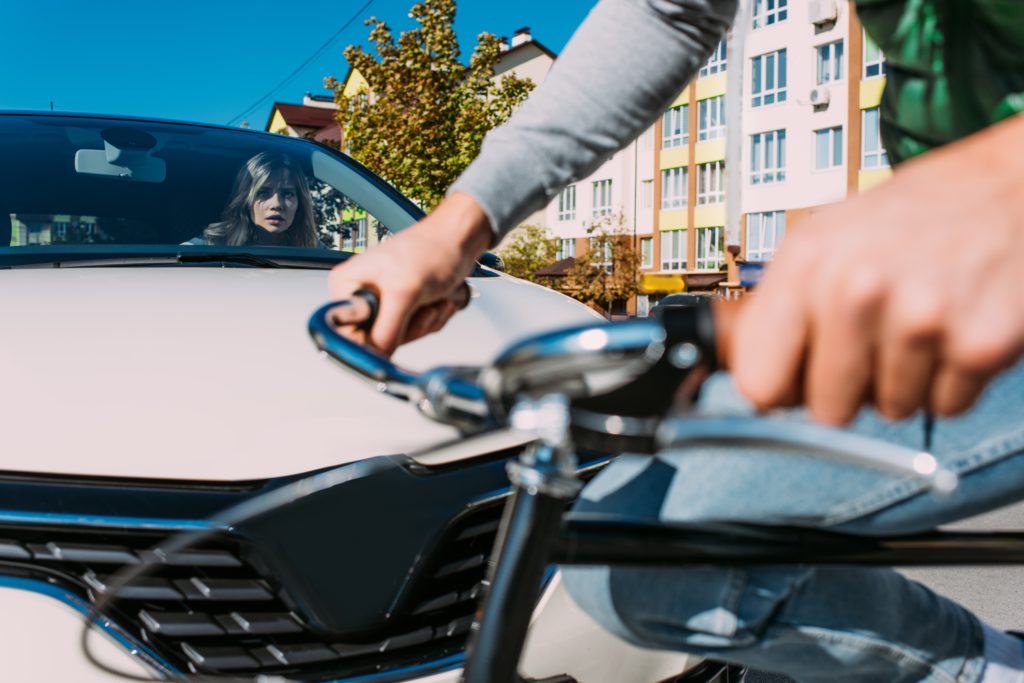Cyclist at Fault Car Accident

The Arizona Department of Transportation reports that in 2017 there were more than 1,400 accidents involving a collision between cyclists and cars, with more than 30 fatalities.
Although motor vehicle drivers are more likely to be at fault in an accident with a bicycle, it is possible for cyclists to be the cause of accidents.
Steps to take after you’ve been in an accident with a cyclist
First and foremost, when an accident occurs, you must stop—otherwise, you risk being charged with a hit-and-run. You should check to see if anyone needs emergency medical assistance.
After you’ve handled any medical emergencies, you should exchange your contact and insurance information with the other party, and then file a police report as soon as possible. This will create a record of the accident close to when it occurred. You will need to provide this record to the insurance companies if you want to make a claim for damages.
At this stage, the driver’s negligence compared to the cyclist’s negligence may not be evident, and you should speak with a personal injury attorney to determine your options for moving forward.
Determining who is at fault
Arizona is a comparative negligence state in personal injury cases. This means in motor vehicle accident cases, the court will look at the relative negligence of both parties when issuing an award. The plaintiff’s award will be decreased by the percent the plaintiff was at fault.
Arizona requires that cyclists follow the rules of the road. They must follow the same traffic laws as motor vehicles. Specifically, they must:
- Stop at red lights and stop signs
- Yield to pedestrians
- Stay on the right side of the road, unless passing or turning left.
Additionally, when biking at night, cyclists must use a white headlight and red rear reflector to increase visibility. Bikers should not be distracted by their cell phones, and they should not ride while drunk. If a cyclist fails to follow these rules, it’s possible that he or she will be found to be at fault for some or the majority of the accident.
Real-Life Example
For example, Paul is driving down the street and sees his light turn from green to yellow. He decides to go through the light before it changes, and increases his speed slightly. He enters the intersection while the light is yellow, and his light turns red while he is in the intersection. Karen is also approaching this intersection on her bicycle, but from a perpendicular angle to Paul. She had a few beers with her friends and is texting her mom. She does not see that her light is still red, and enters the intersection at the same time as Paul does, which causes Paul to hit her.
In this scenario, Paul’s comparative negligence – speeding up to catch the light – might contribute to 10% of the accident, while Karen’s comparative negligence – texting, riding under the influence, and running the red light – contributed to 90% of the accident.
If Paul sues Karen, his money damages would be decreased by the 10% he was at fault. Similarly, if Karen sues Paul, her money damages would be decreased by 90%.
Preventing bicycle accidents
Regardless of who is at fault in a bike accident, the person on the bike is likely to be more injured than the person in the car. Bicyclists do not want to be injured, and drivers do not want to be the cause of serious injury or death.
- When you’re driving, be alert for cyclists, especially at intersections. Give bicyclists extra space when passing. Use your turn signals, so cyclists can tell if you are going to make a turn in front of them.
- When you’re on a bike, follow the rules of the road. Stop at stop signs and stop lights, even if you’ll lose momentum. Use proper signals to let other drivers know when you’ll be turning. Be visible – wear bright colors and use lights and reflectors if you are biking at night. Although you are not required to wear a helmet in Arizona if you’re over 18, wearing one can prevent serious brain injuries in an accident.
Everyone should drive defensively and safely. Nobody should operate a bicycle or drive while intoxicated, and nobody should text while driving or cycling.
This article does not provide legal advice. If you were in an accident and believe the cyclist was at fault, contact our experienced personal injury attorneys for a free consultation today.
